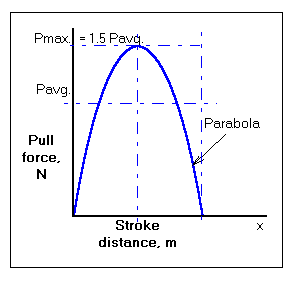 Figure 1
Figure 1
Select a "piece" representative of the course distance for which you wish to optimize your rigging. Row the piece, pacing yourself as you would on the water, for the required length of time you expect to take on the course. Note the number of strokes and adjust the fanwheel damper to correct the rating, repeating the process until it more or less agrees with your actual rating on the water. Now, row a piece "for real" and at the end note down your average pull handle force (available on Concept-II's PM2). If we can assume the typical force profile to be more or less parabolic then the average peak force will be the average force times 3/2 (1.5). Knowing this force is essential to the optimization of sweep lever ratio.
 Figure 1
Figure 1
Ergometer chain-pull is not the same as oarhandle pull as commonly measured in the boat (by monitoring oarshaft bending with strain detection devices). What is measured on the water is the force normal to the shaft and what is measured on the erg is the "boat" longitudinal force. This force is really a shaft angle (sine) function of the shaft-normal force. When the shaft is at ninety degrees to the boat the two forces coincide and insofar as the erg peak may be near this point the erg estimate has validity for the boat as well.
Insofar as peak pull may be related to oarhandle drive time I will be interested to hear from those who may try this method of estimating peak pull. Indications from the field seem to show no clear relation between peak pull and stroke rating.